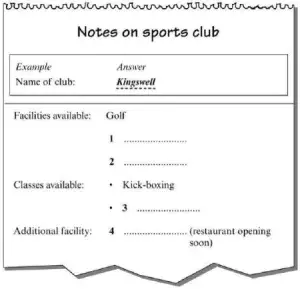Techniques For Success…
Just from looking at this form we can predict that the two people are going to talk about employment and that they do not know each other.
We can also predict that one of the questions might be something like: when were you born? Or what is your date of birth?
What other questions might you be listening for?
It is also useful to remember that the order of questions follows the order of the recording throughout. This means that if you get lost during the recording and you know that the recording is playing ahead of your last answer, you can use the keywords you have underlined in your questions and listen for those words or synonyms of those words to relocate yourself.
Examiners Tricks…
Distracting comments are also present in the recordings. If you were filling in the above form you might hear the speakers say where they don’t want to work, as well as where they do want to work. They might even say when they can’t work before when they can work.
Often candidates will have to listen intensively for the spelling of a name or place, as in the example above. This means you will need to be able to tell the difference between similar sounding letters such as ‘i’ and ‘e’ and numbers like four and fourteen when they are spoken.
 Between recordings there is time to read the next set of questions.
Between recordings there is time to read the next set of questions.
This is when you should underline the keywords in the questions, so candidates know what key words to listen out for and to begin making predictions.
Often candidates struggle with the speed of the speakers. It is helpful to know that often the keywords in a sentence are verbs and nouns which the speaker will often place greater stress or emphasis on.
Other words in a sentence are usually shorter, such as articles (a, an, and, the), prepositions (for, to, on) and auxillary verbs (am, is, was, were). These are often said more quickly and can be difficult to ‘catch’ however missing them does not mean you cannot get the correct meaning or identify the key word you need!
Essentially, that is how to do IELTS Listening Part 1. Practicing the techniques mentioned above using real exam papers is important to improve your technique.
To improve your actual ability to listen to general conversations like this, you can try these sites here which have plenty of naturally spoken conversational English similar to what you might hear in IELTS Listening Part 1, transcripts are also included: manythings.org and esl-lab.com.
If you have any hints, tips or web-sites that you recommend for listening practice please let me know in the comments section below.
 IELTS Listening Part 1 is usually a general everyday conversation between two people. Once you have read what the questions are you will know what the general topic is. You may even be able to predict the questions the speakers are going to ask and answer.
IELTS Listening Part 1 is usually a general everyday conversation between two people. Once you have read what the questions are you will know what the general topic is. You may even be able to predict the questions the speakers are going to ask and answer.





